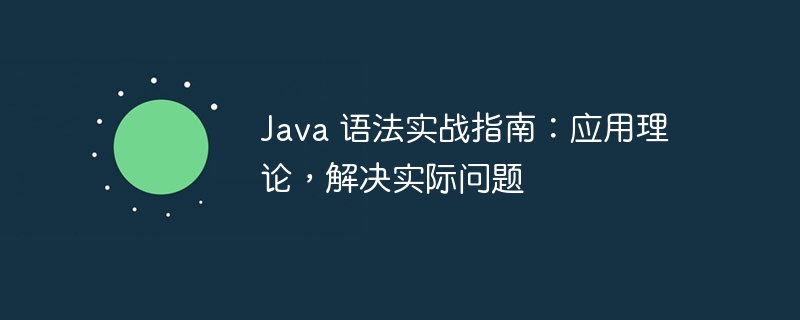Home >Java >javaTutorial >A Practical Guide to Java Syntax: Applying Theory to Solve Practical Problems
A Practical Guide to Java Syntax: Applying Theory to Solve Practical Problems
- 王林forward
- 2024-04-03 13:07:191147browse

Java is a high-level programming language widely used in the field of computer programming. For novices, learning and applying Java syntax may be difficult. In this article, PHP editor Banana will provide you with a practical guide on Java syntax application to help readers better understand the basic concepts of Java applications and solve problems encountered in the actual development process. Through learning and practical combat, we believe that readers can better master Java programming and improve your programming abilities.
- Understand the difference between basic data types and reference data types.
- Declare and initialize variables, and understand their scope and life cycle.
- Proficient in using type conversion and coercion.
2. Control flow
- Use conditional statements (if-else) to control program flow.
- Use loops (for, while, do-while) to repeat code.
- Master the switch-case statement for multi-way branching.
3. Methods and overloading
- Create and call methods, and understand their parameters and return values.
- Understand method overloading and master its advantages and disadvantages.
- ApplyRecursiontechniques to solve complex problems.
4. Classes and objects
- Create and use classes to organize code and encapsulate data.
- Initialize the object and access its fields and methods.
- Understand inheritance and polymorphism and apply them to reuse code.
5. Collection framework
- Proficient in using collections classes (such as List, Set, Map) to store and manage data.
- Apply generics to ensure type safety .
- Master iterators and Lambda expressions to efficiently traverse collection elements.
6. Input and output
- Use Scanner or BufferedReader to get input from the console.
- Use PrintStream or BufferedWriter to write output to the console or file.
- Understand file reading and writing, and master the best practices for file processing.
7. Exception handling
- Understand exceptions and their types.
- Use try-catch statement to handle exceptions.
- Master throwing and catching exceptions to ensure the robustness of the code.
8. Multi-threading
- Create and manage threads to achieve parallel programming.
- Understand synchronization and mutual exclusion to avoid thread safety issues.
- Apply locks and synchronization mechanisms to ensure multi-threading data correctness.
9. Java 8 features
- Understand Lambda expressions and master their applications in collections, streams, and functional programming.
- Use streamsapi to implement complex data processing operations.
- Explore new features like Optional and DateTime API.
10. Practical projects
- Consolidate your grammar knowledge with hands-on projects.
- Design and write applications to solve real-world problems.
- Understand the Java ecosystem, including frameworks , libraries, and tools .
The above is the detailed content of A Practical Guide to Java Syntax: Applying Theory to Solve Practical Problems. For more information, please follow other related articles on the PHP Chinese website!

